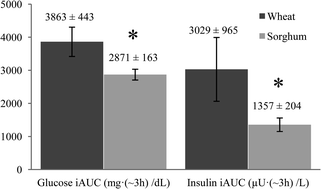Grain sorghum muffin reduces glucose and insulin responses in men
Abstract
Diabetes and obesity have sparked interest in identifying healthy, dietary carbohydrates as functional ingredients for controlling blood glucose and insulin levels. Grain sorghum has been known to be a slowly digestible cereal; however, research is limited on its health effects in humans. The objectives of this study were to measure the contents of functional starch fractions, SDS (slowly-digestible starch) and RS (resistant starch), and to investigate the effects of grain sorghum on postprandial plasma glucose and insulin levels in 10 healthy men. A whole-wheat flour muffin (control) was compared with the grain sorghum muffin with both muffins containing 50 g of total starch. Using a randomized-crossover design, male subjects consumed treatments within a one-week washout period, and glucose and insulin levels were observed at 15 minutes before and 0, 15, 30, 45, 60, 75, 90, 120, 180 minutes after consumption. The mean glucose responses reduced after consuming grain sorghum, particularly at 45–120 minute intervals, and mean insulin responses reduced at 15–90 minute intervals compared to control (P < 0.05). The mean incremental area under the curve (iAUC) was significantly lowered for plasma glucose responses about an average of 35% from 3863 ± 443 to 2871 ± 163 mg (∼3 h) dL−1 (P < 0.05). Insulin responses also reduced significantly from 3029 ± 965 μU (∼3 h) L−1 for wheat to 1357 ± 204 with sorghum (P < 0.05). Results suggest that grain sorghum is a good functional ingredient to assist in managing glucose and insulin levels in healthy individuals.


 Please wait while we load your content...
Please wait while we load your content...